Philippine sailfin lizard
The Philippine sailfin lizard,[2] crested lizard, sail-fin lizard, sailfin water lizard, soa-soa water lizard[1] (Hydrosaurus pustulatus) or its native name ibid is an oviparous lizard living only in the Philippines.
| Philippine sailfin lizard | |
|---|---|
 | |
| At Tropicario in Helsinki, Finland | |
| Scientific classification | |
| Kingdom: | Animalia |
| Phylum: | Chordata |
| Class: | Reptilia |
| Order: | Squamata |
| Suborder: | Iguania |
| Family: | Agamidae |
| Genus: | Hydrosaurus |
| Species: | H. pustulatus |
| Binomial name | |
| Hydrosaurus pustulatus (Eschscholtz, 1829) | |
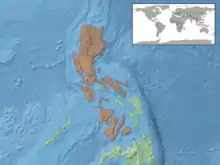 | |
Local name is bayagbag.
Behavior and appearance
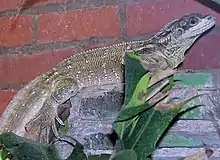
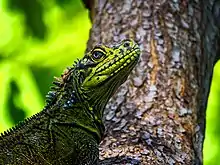
The Philippine sailfin lizard is an excellent swimmer and has flattened toes that enable it to run across water, similar to the basilisks.[3] It is omnivorous, feeding on fruit, leaves, flowers, insects, and small animals . Males have a larger crest on their back than the females. The males also show a violet color as they grow older. Females are less colorful. The adults may reach up to a metre in length.
Habitat and taxonomy
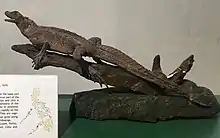
The Philippine sailfin lizard lives in tropical wooded habitats near water, like rivers, riverbanks, rice-fields and mangrove.[1][4] Due to confusion with H. amboinensis, the exact distribution in the Philippines has been labelled with some uncertainty.[1] However, a genetic study that sampled individuals throughout the Philippine archipelago (from Mindanao in south to Luzon in north) found that all were H. pustulatus, which is divided into six clades.[4]
Conservation
Philippine sailfin lizards have now been classified as Vulnerable by the IUCN.[1] Their main threats are habitat loss, being hunted for food, and collection for the pet trade.
In captivity
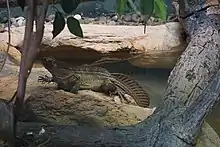
Philippine sailfin lizards were commonly available in the United States during the 1990s, but today they are now rare and expensive in the United States (costing about $650 for a captive bred juvenile). Breeding in captivity has only been done in a few cases.
But because it is common in many parts of the Philippines, the pet trade in many regions still continues and some are even unrecognized by the government.
References
| Wikimedia Commons has media related to Hydrosaurus pustulatus. |
- Ledesma, M.; Brown, R.; Sy, E.; Rico, E.L. (2009). "Hydrosaurus pustulatus". The IUCN Red List of Threatened Species. IUCN. 2009: e.T10335A3194587. doi:10.2305/IUCN.UK.2009-2.RLTS.T10335A3194587.en. Retrieved 15 January 2018.
- H. pustulatus, The Reptile Database
- Jackman Bauer (2008). Global diversity of lizards in freshwater (Reptilia: Lacertilia). Hydrobiologia 595(1): 581–586.
- Cameron D. Siler, Andrés Lira-Noriega, Rafe M. Brown (2014). Conservation genetics of Australasian sailfin lizards: Flagship species threatened by coastal development and insufficient protected area coverage. Biological Conservation 169: 100–108. doi:10.1016/j.biocon.2013.10.014
